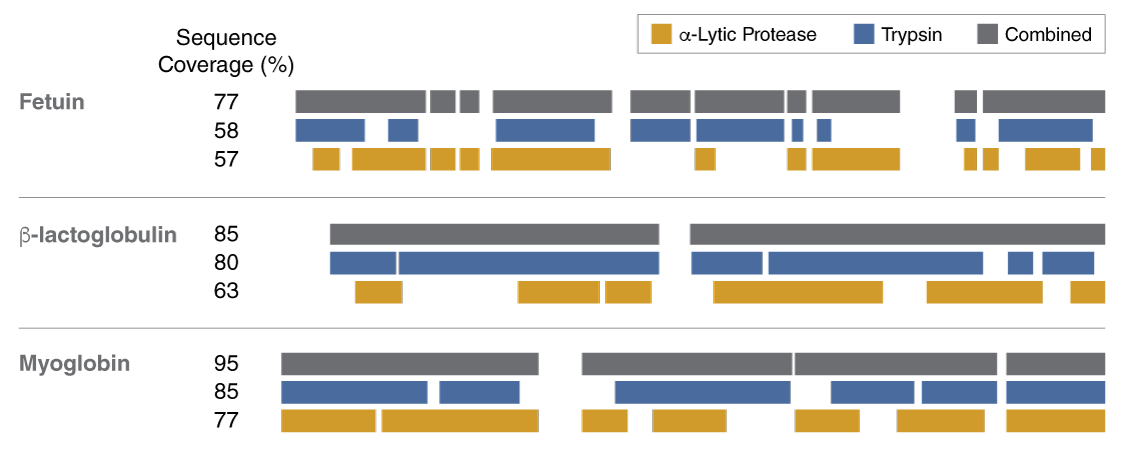上海金畔生物科技有限公司代理New England Biolabs(NEB)酶试剂全线产品,欢迎访问官网了解更多产品信息和订购。
产品信息
α-Lytic Protease (aLP) cleaves after Threonine (T), Alanine (A), Serine (S) and Valine (V) residues. Its specificity makes it an orthogonal and alternative protease to others commonly used in proteomics applications, including trypsin and chymotrypsin. Peptides generated by aLP are of similar average length to those of Trypsin.


产品来源
Purified from Lysobacter enzymogenes
- 产品类别:
- Proteases Products,
- Proteome Analysis Products
- 应用:
- Protein Analysis Tools,
- Protein Digestion,
- Proteomics
-
产品组分信息
本产品提供以下试剂或组分:
NEB # 名称 组分货号 储存温度 数量 浓度 -
P8113S -20 α-Lytic Protease P8113SVIAL -20 1 x 20 µg 0.4 mg/ml
-
P8113L -20 α-Lytic Protease P8113SVIAL -20 5 x 20 µg 0.4 mg/ml
-
-
特性和用法
贮存溶液
10 mM sodium acetate
pH 5 @ 25°C热失活
95°C
分子量
实际: 19.8 kDa
-
优势和特性
Features
- Digestion of proteins for proteomic analysis by mass spectrometry
- Protein and peptide identification
- Site-specific identification and quantitation of endogenous SUMO modifications under native conditions(1).
- Cleavage after aliphatic amino acids resulting in increased sequence coverage of membrane proteins
-
相关产品
相关产品
- Endoproteinase GluC
- Trypsin-ultra™, Mass Spectrometry Grade
- Endoproteinase AspN
- Endoproteinase LysC
-
注意事项
- α-Lytic Protease is stable for at least 2 years at –20°C. No loss of activity is observed after 10 freeze-thaw cycles.
- To avoid autolysis, α-Lytic Protease should be stored long term in 10 mM Sodium Acetate pH 5.0.
- α-Lytic Protease is active in a variety of mass spectrometry compatible buffers including ammonium bicarbonate, Tris-HCl, and HEPES. The optimal pH range for α-Lytic Protease digestion is pH 7.5 – 8.5.
- Enzyme activity is stimulated in up to 0.1% sodium deoxycholate(2).
- Enzyme activity is inhibited by 1.0% sodium deoxycholate (~60% active); 0.1% SDS (~50 active); 1% SDS (~40% active); 1 M guanidine hydrochloride (~20% active); 4 M guanidine hydrochloride (no activity); Serine protease inhibitors, such as PMSF (no activity)(2).
- α-Lytic Protease is compatible with both in-solution and in-gel digestion methods. Digestion with α-Lytic Protease yields increased peptide recovery for standard and crushed gel conditions of large molecular weight proteins(3).
- α-Lytic Protease is active over a wide temperature range from 4ºC – 50ºC, with optimal activity at 37ºC. Lower temperatures may require longer incubation times.
-
参考文献
- Lumpkin, RJ. et al. (2017). Nat Commun.. 8 (1), 1171.
- Meyer, JG. et al. (2014). Molecular & Cellular Proteomics. 13 (3), 823-835.
- Ruse, C. New England Biolabs, Inc.. Unpublished observation
操作说明、说明书 & 用法
-
操作说明
- α-Lytic Protease In-gel Digestion Protocol (NEB #P8113)
- α-Lytic Protease Typical Reaction Protocol (NEB #P8113)
工具 & 资源
-
选择指南
- Protease Selection Chart
FAQs & 问题解决指南
-
FAQs
- What reaction buffers are recommended for use with α-Lytic Protease?
- Can I perform my digest with α-Lytic Protease at temperatures other than 37°C?
- Why should I use α-Lytic Protease instead of Trypsin?
- Is there an advantage to treating my sample with both α-Lytic Protease and Trypsin?
- What reagents inhibit α-Lytic Protease activity?
- What reagents stimulate α-Lytic Protease activity?
- Can α-Lytic Protease be heat-inactivated?
